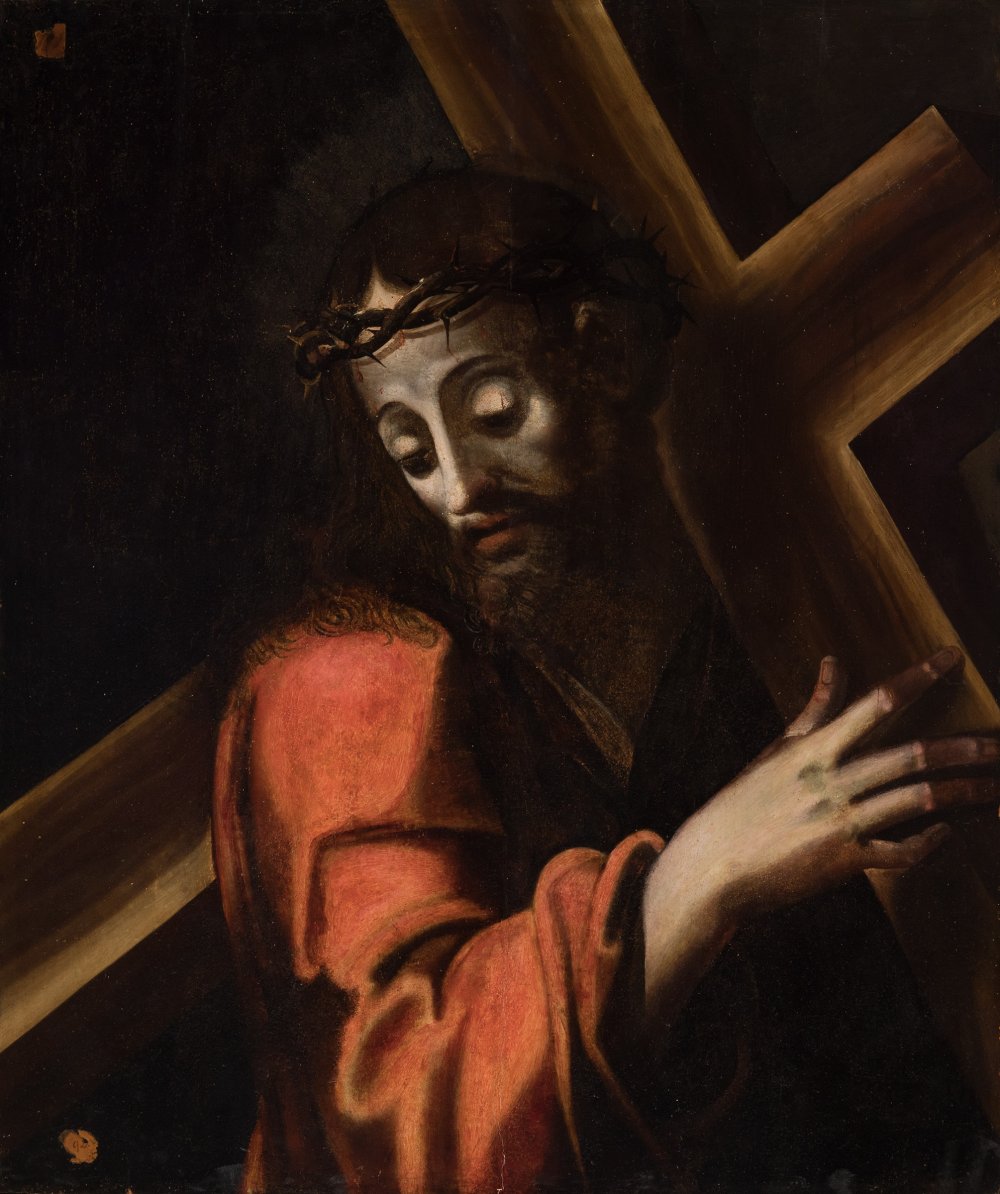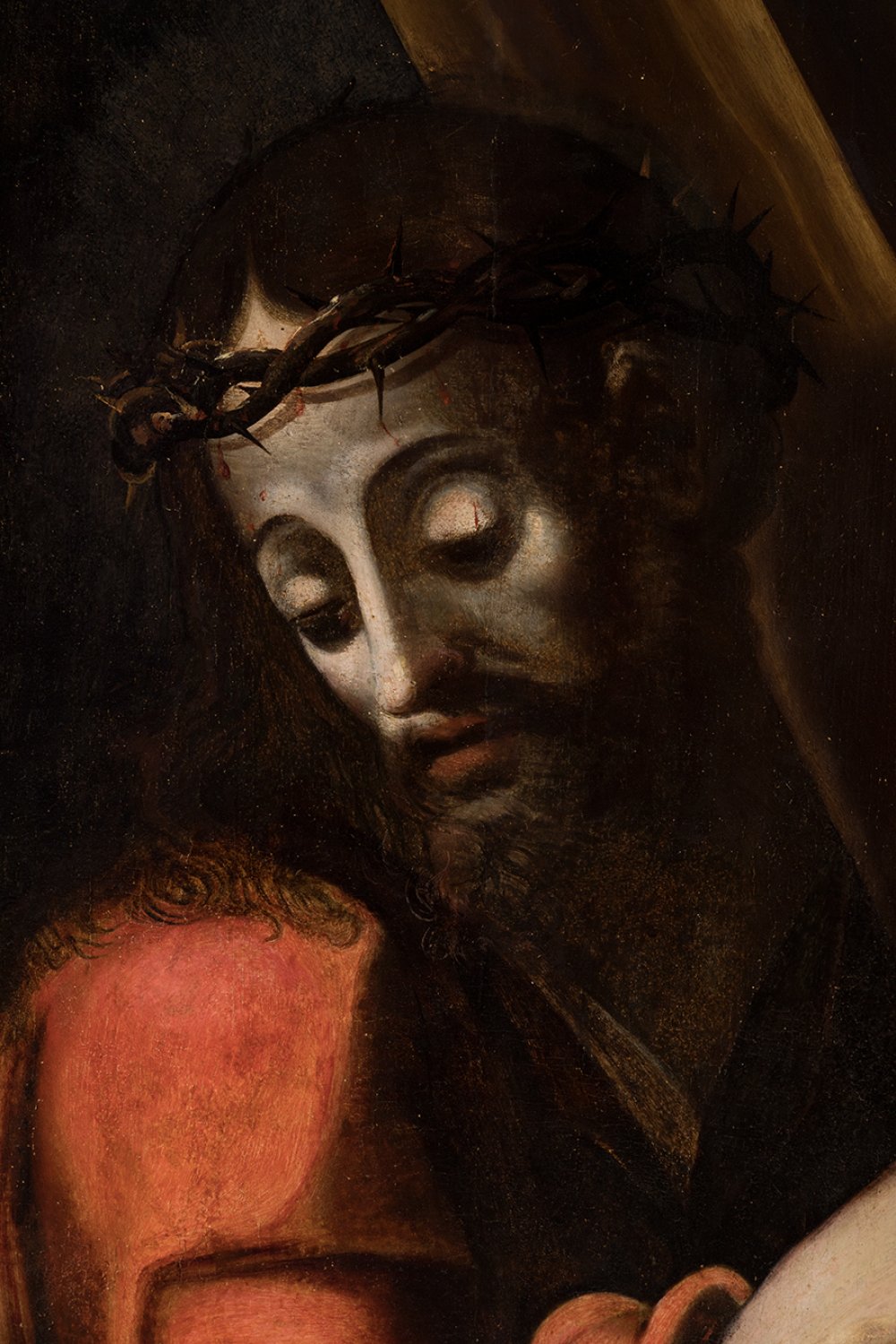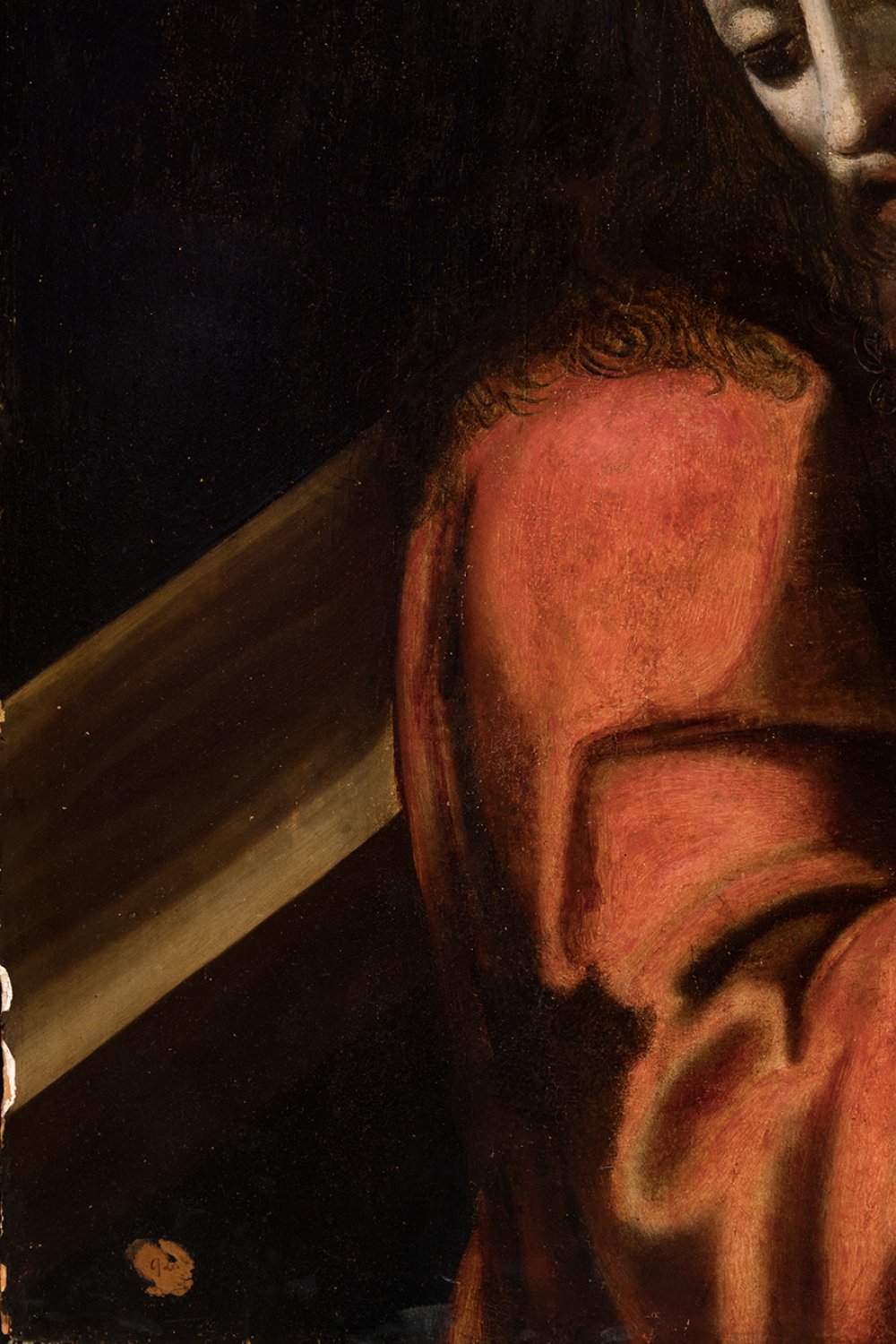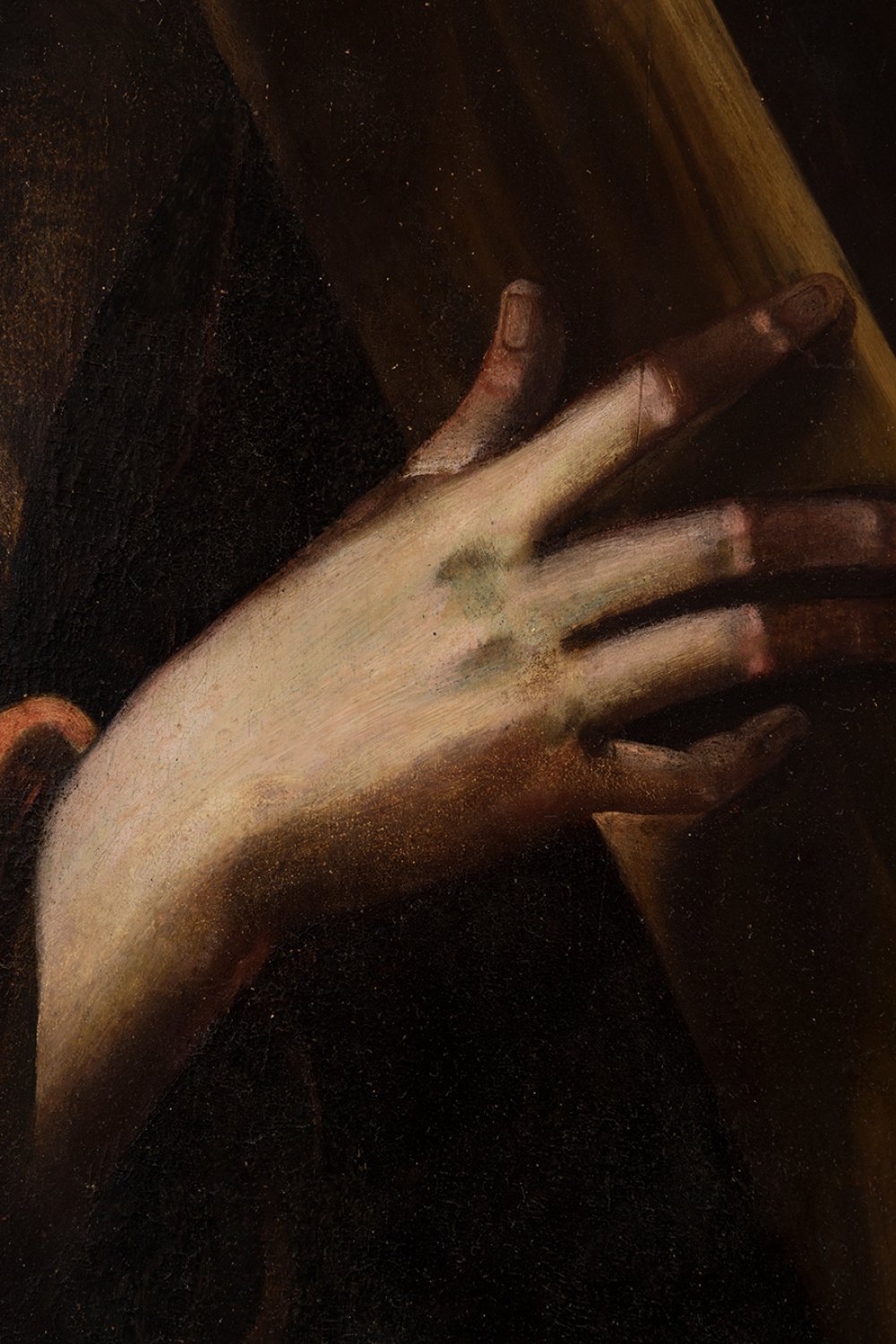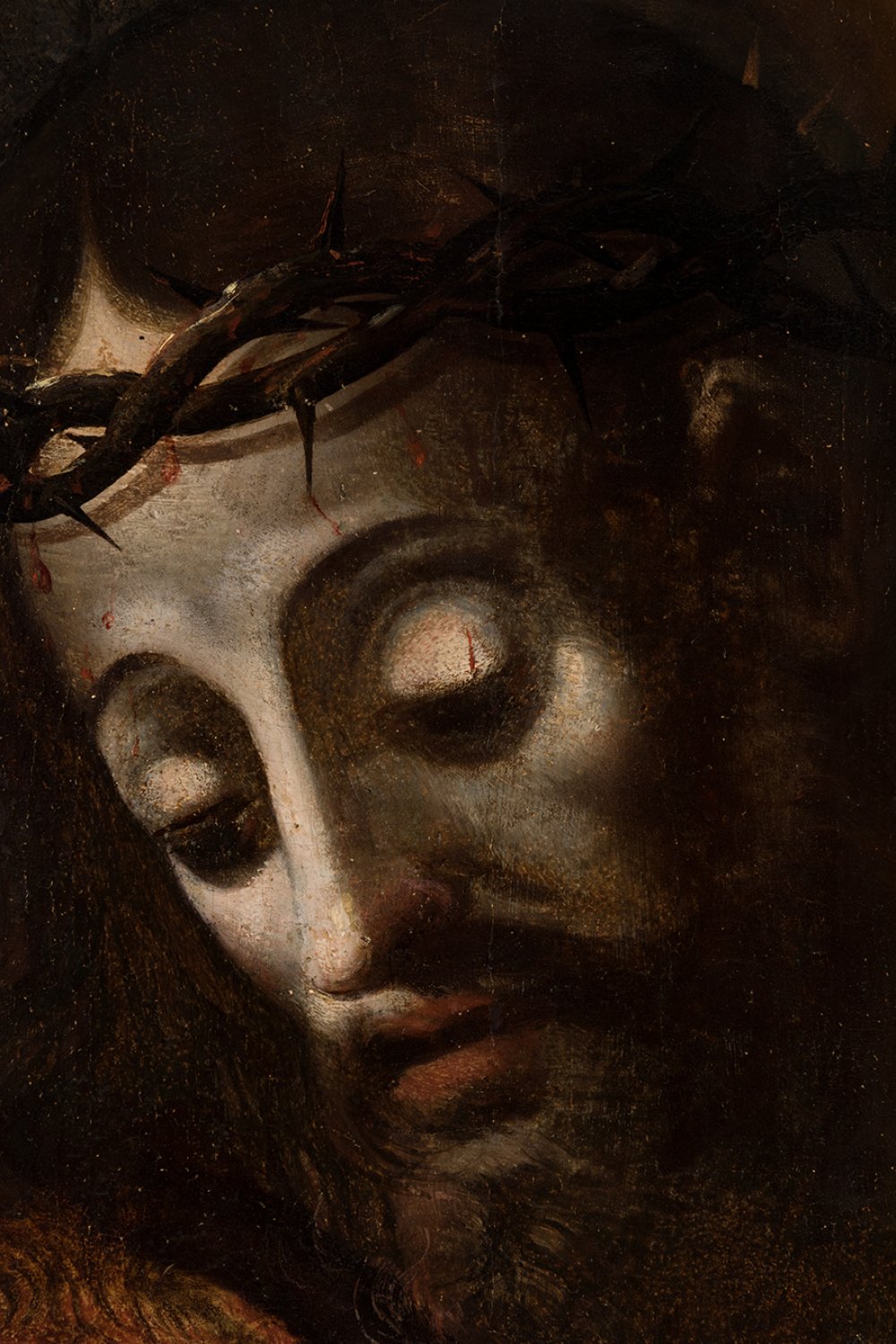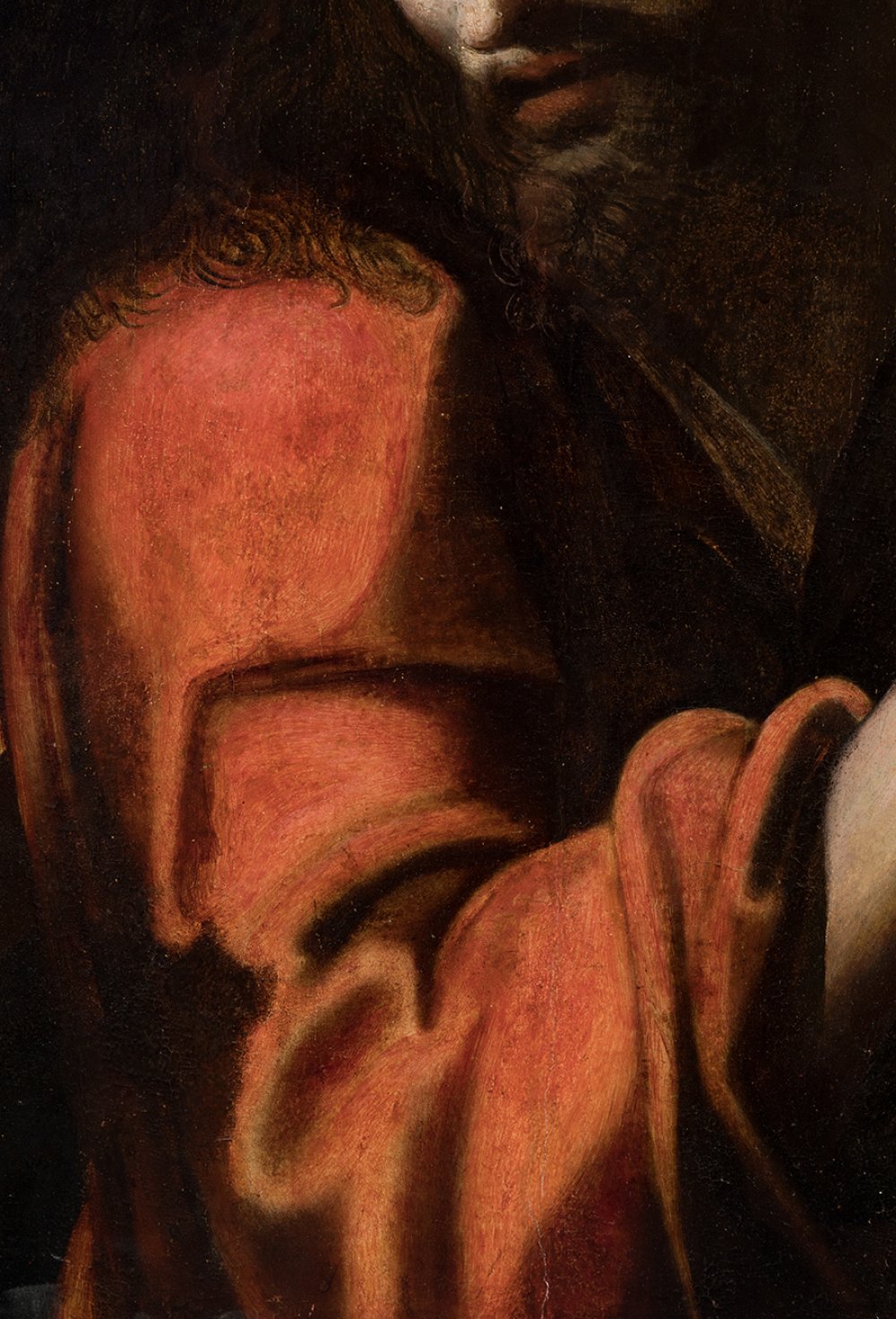12
Follower of SEBASTIANO DEL PIOMBO (Venice, 1485 - Rome, 1547)."Christ with cross-bearer".Oil on pine
"Christ with cross-bearer".
Oil on pine panel.
It has restorations and repainting.
Measurements: 77 x 65 cm.
In this canvas the author captures one of the most dramatic moments of the Via Crucis, the moment in which Christ supports the weight of the cross. In this episode it is common to see Simon the Cyrenean helping Jesus to carry the cross, or Veronica offering him a cloth to wipe his face clean of blood and sweat. However, the author of this canvas dispenses with these figures and seeks no theological meaning other than that of Christ's own suffering and voluntary sacrifice on behalf of humanity. In fact, this supreme generosity is reinforced by Jesus' own gaze, which avoids ours, turning to one side, towards something we do not see because it is outside the painting. On the other hand, compositionally, everything is designed to enhance the figure of Christ. It should be noted that the piece aesthetically follows the aesthetic precepts set by the painter Sebastiano Piombo, specifically those established with his work "Christ Carrying the Cross", painted between 1532 and 1535, which is now in the art collection of the Prado Museum in Madrid.
Sebastiano del Piombo (Venice, ca. 1485/1486-Rome, 1547). He trained with Giovanni Bellini and Giorgione, whose influence is evident in his early work, which dates from 1505 and is surprising for its compositional and iconographic innovations. Works such as the Judgement of Solomon (Bankes Collection, Kingston Lacy), Saint John Chrysostom with Saints (Saint John Chrysostom, Venice), the organ doors of the church of San Bartolomeo in Rialto and Salome (National Gallery, London) established Sebastiano as the most influential and talented Venetian painter after Giorgione's death in 1510 and before the definitive emergence of Titian. However, in August 1511 he accepted Agostino Chigi's invitation to move to Rome, where he spent the rest of his life, except for sporadic absences. Between 1511 and the Saco of 1527 was the most prolific period of his career. His first Roman work was the fresco decoration of the lunettes in the loggia of the garden of the Villa de Chigi, later known as "La Farnesina", including Polyphemus, painted in the Giorgionesque manner without a preliminary drawing. Around 1512 he also painted Cardinal Ferry Carondelet with his secretary (Museo Thyssen-Bornemisza, Madrid), in which the model is shown for the first time in Italy engaged in an occupation, and The Death of Adonis (Galleria degli Uffizi, Florence), which reveals his knowledge of Michelangelo and Raphael. Sebastiano's relationship with both was uneven, and while he had an open rivalry with Raphael, he enjoyed the friendship of Michelangelo, who provided him with models, for example for the Pietà (Museo Civico, Viterbo), one of his masterpieces, executed between 1513 and 1516 and commissioned by Cardinal Giovanni Botonti. Michelangelo is also known to have supplied him with designs for the paintings in the Borgherini chapel in San Pietro in Montorio (Rome), and for the Resurrection of Lazarus (National Gallery, London), commissioned in 1516 by Cardinal Julius de' Medici, the future Clement VII.
"Christ with cross-bearer".
Oil on pine panel.
It has restorations and repainting.
Measurements: 77 x 65 cm.
In this canvas the author captures one of the most dramatic moments of the Via Crucis, the moment in which Christ supports the weight of the cross. In this episode it is common to see Simon the Cyrenean helping Jesus to carry the cross, or Veronica offering him a cloth to wipe his face clean of blood and sweat. However, the author of this canvas dispenses with these figures and seeks no theological meaning other than that of Christ's own suffering and voluntary sacrifice on behalf of humanity. In fact, this supreme generosity is reinforced by Jesus' own gaze, which avoids ours, turning to one side, towards something we do not see because it is outside the painting. On the other hand, compositionally, everything is designed to enhance the figure of Christ. It should be noted that the piece aesthetically follows the aesthetic precepts set by the painter Sebastiano Piombo, specifically those established with his work "Christ Carrying the Cross", painted between 1532 and 1535, which is now in the art collection of the Prado Museum in Madrid.
Sebastiano del Piombo (Venice, ca. 1485/1486-Rome, 1547). He trained with Giovanni Bellini and Giorgione, whose influence is evident in his early work, which dates from 1505 and is surprising for its compositional and iconographic innovations. Works such as the Judgement of Solomon (Bankes Collection, Kingston Lacy), Saint John Chrysostom with Saints (Saint John Chrysostom, Venice), the organ doors of the church of San Bartolomeo in Rialto and Salome (National Gallery, London) established Sebastiano as the most influential and talented Venetian painter after Giorgione's death in 1510 and before the definitive emergence of Titian. However, in August 1511 he accepted Agostino Chigi's invitation to move to Rome, where he spent the rest of his life, except for sporadic absences. Between 1511 and the Saco of 1527 was the most prolific period of his career. His first Roman work was the fresco decoration of the lunettes in the loggia of the garden of the Villa de Chigi, later known as "La Farnesina", including Polyphemus, painted in the Giorgionesque manner without a preliminary drawing. Around 1512 he also painted Cardinal Ferry Carondelet with his secretary (Museo Thyssen-Bornemisza, Madrid), in which the model is shown for the first time in Italy engaged in an occupation, and The Death of Adonis (Galleria degli Uffizi, Florence), which reveals his knowledge of Michelangelo and Raphael. Sebastiano's relationship with both was uneven, and while he had an open rivalry with Raphael, he enjoyed the friendship of Michelangelo, who provided him with models, for example for the Pietà (Museo Civico, Viterbo), one of his masterpieces, executed between 1513 and 1516 and commissioned by Cardinal Giovanni Botonti. Michelangelo is also known to have supplied him with designs for the paintings in the Borgherini chapel in San Pietro in Montorio (Rome), and for the Resurrection of Lazarus (National Gallery, London), commissioned in 1516 by Cardinal Julius de' Medici, the future Clement VII.
7th September - Old Masters
Sale Date(s)
Venue Address
General delivery information available from the auctioneer
Setdart offers Worldwide shipping
PICK UP IN ROOM: You can come and pick up your lots in our offices (Barcelona, Madrid or Valencia). At the moment of the withdrawal, you will be able to accept the current conditions of the lot by means of a document that you will sign.
YOU CAN SEND ANOTHER PERSON TO PICK UP: This person must present a signed authorization that you can find in our web page by accessing from BUY AT SETDART- LOGISTICS-DOWNLOAD AUTHORIZATION DOCUMENT. You can also send an e-mail with the requested data in AUTHORIZATION DOCUMENT to admin@setdart.com
Important Information
25% buyer´s premium
21% buyer´s premium at www.setdart.com
Terms & Conditions
The maximum period to pay the lots is 7 working days. You can pay either via bank transfer or with credit card through our platform www.setdart.com (we only accept VISA or Mastercard).
BUYER´S PREMIUM: 22% Hammer price + 21% VAT from the buyer´s premium
If your piece has more than 100 years, our Ministry of Culture requires an export certificate in order for the piece to leave the country. Note that if the piece goes inside the EU, there is no cost for the export certificate. If the piece goes outside the EU, there is a cost for the export certificate. You can find more information in our Ministry of Culture website: https://www.culturaydeporte.gob.es/en/cultura/patrimonio/exportacionimportacion/exportacion/tasas.html
INQUIRIES: admin@setdart.com
Setdart guides you through the entire process, from the time of award to the day you receive your lot. Our logistics team will be happy to manage your transport, and will advise you on the best shipping method with professionals from the sector used to handling works of art and jewelry.
WE OFFER WORLDWIDE DOOR TO DOOR SHIPPING
PICK UP IN ROOM: You can come and pick up your lots in our offices. At the moment of the withdrawal, you will be able to accept the current conditions of the lot by means of a document that you will sign.
YOU CAN SEND ANOTHER PERSON TO PICK UP: This person must present a signed authorization that you can find in our web page by accessing from BUY AT SETDART-LOGISTICS-DOWNLOAD AUTHORIZATION DOCUMENT. You can also send an e-mail with the requested data in AUTHORIZATION DOCUMENT to admin@setdart.com
SETDART IS NOT RESPONSIBLE FOR THE STATE OF THE PARTS ONCE THEY LEAVE OUR FACILITIES. MRW SHIPMENTS: Once the payment is made, your lot will be packed for shipment, the logistics department will send you an e-mail notifying you of the day it leaves our warehouse, changes of address cannot be made after receiving this e-mail.
INSURANCE INCIDENTS: Coverage for the value of the auction up to 3000 ? per shipment, if the value of the auction is higher, Setdart will send you a quote including the additional insurance. The insurance company WILL NOT BE RESPONSIBLE FOR THE SHIPMENT THAT EXCEEDS THAT AMOUNT AND IS NOT FULLY INSURED. MRW INCIDENTS: Maximum notification 48 hours after receipt, after which the insurance company WILL NOT BE RESPONSIBLE AND NO CLAIMS WILL BE ACCEPTED.
E-MAIL LOGISTICS: logistica@setdart.com
PICK UP YOUR MESSAGES: You can send your own messaging, prior notice via e-mail that your shipment is ready, please note 3 or 4 days in advance. This type of shipment is packaged so Setdart will provide you with a quote.
EXPENSES FOR STORAGE: We inform you that if the purchased lot is not picked up within a month, you will be charged 30€ per week per lot. Setdart Online S.L., owner of the web site "setdart.com", "setdart.net" and "setdart.org", acts as a company of Spanish nationality inscribed in the Volume 36955, sheet 182, page B-293056 of the Mercantile Registry, with registered office at Calle Aragó















